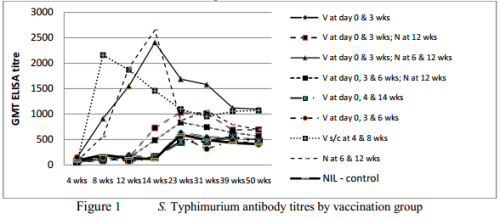



Salmonella Vaccination in Layers
The live vaccine given orally to layer pullets only gave short–term protection against Salmonella Typhimurium, reported P.J. Groves from the University of Sydney to the 2011 Australian Poultry Science Symposium.Live attenuated vaccines and inactivated bacterins against Salmonella serovars are available in Australia. These have had some use in meat breeder chickens but have yet to be considered by the commercial layer industry. Australian commercial flocks are free of S. Enteritidis, so the focus here is mainly against S. Typhimurium and other less common serovars.
A project is underway to evaluate the effectiveness of a live and an inactivated vaccine in preventing or decreasing Salmonella intestinal colonisation in layer breeds. A selection of results is presented here.
Seven hundred and seventy-four brown egg layer breed day-old chicks were obtained from a commercial hatchery and placed into nine floor pens in a trial facility. Vaccination programmes were administered to all birds in one pen each as shown in Figure 1. Live vaccine (Bioproperties Vaxsafe ST; designated V) was given by oral gavage in all groups except for the group given this vaccine by subcutaneous injection (s/c) at four and eight weeks. Inactivated vaccine (Intervet trivalent Salmonella vaccine; designated N) was given by intramuscular injection. All vaccines were given at one label dose per bird (for the live vaccine at this time, this was 10 organisms per bird). At 18 weeks of age, the birds were moved from the floor pens into individual cages at the University of Sydney.
Ten birds per group were bled at 4, 8, 12, 14, 23, 31, 39 and 50 weeks of age and their sera tested for S. Typhimurium antibody using the x-Ovo (Guildhay) ELISA (the cut off point for a positive result with this ELISA is >784 units). At 4, 10, 17, 20 24, 32 and 50 weeks,
birds from each group were removed to floor pens and challenged with an oral dose of 108 colony-forming units (cfu) of a field strain of S. Typhimurium per bird. Twenty-one days later, these birds were euthanised and their caeca cultured for presence of Salmonellae.

Seroconversion was only achieved following inactivated vaccine or live vaccine given subcutaneously. Only the dual live vaccine given by injection or two doses of inactivated vaccine following oral live dosing gave serological results lasting to 50 weeks of age.
Challenge and recovery of S. Typhimurium proved difficult to achieve, even in unvaccinated birds. Higher serum antibody levels were associated with higher protective index against challenge. The live vaccine given orally only gave short–term protection.
Reference
Groves P.J., S.M. Sharpe and W.I. Muir. 2011. Salmonella vaccination of layers. Proceedings of the Australian Poultry Science Symposium. Sydney, Australia. February 2011. p247.
Further Reading
| - | You can view the Proceedings of the 22nd Annual Australian Poultry Science Symposium by clicking here. |
April 2012








